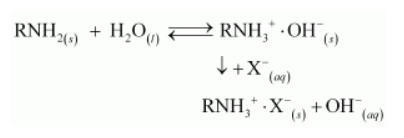Discuss the principle and method of softening of hard water by synthetic ion-exchange resins.
The process of treating permanent hardness of water using synthetic resins is based on the exchange of cations (e.g., $\mathrm{Na}^{+}, \mathrm{Ca}^{2+}, \mathrm{Mg}^{2+}$ etc) and anions (e.g., $\mathrm{Cl}^{-}, \mathrm{SO}_{4}^{2-}, \mathrm{HCO}_{3}^{-}$etc) present in water by $\mathrm{H}^{+}$and $\mathrm{OH}^{-}$ions respectively.
Synthetic resins are of two types:.
1) Cation exchange resins
2) Anion exchange resins
Cation exchange resins are large organic molecules that contain the $-\mathrm{SO}_{3} \mathrm{H}$ group. The resin is firstly changed to $\mathrm{RNa}$ (from $\mathrm{RSO}_{3} \mathrm{H}$ ) by treating it with $\mathrm{NaCl}$. This resin then exchanges $\mathrm{Na}^{+}$ions with $\mathrm{Ca}^{2+}$ and $\mathrm{Mg}^{2+}$ ions, thereby making the water soft.

There are cation exchange resins in $\mathrm{H}^{+}$form. The resins exchange $\mathrm{H}^{+}$ions for $\mathrm{Na}^{+}, \mathrm{Ca}^{2+}$, and $\mathrm{Mg}^{2+}$ ions.

Anion exchange resins exchange $\mathrm{OH}^{-}$ions for anions like $\mathrm{Cl}^{-}, \mathrm{HCO}_{3}^{-}$, and $\mathrm{SO}_{4}{ }^{2-}$ present in water.

During the complete process, water first passes through the cation exchange process. The water obtained after this process is free from mineral cations and is acidic in nature.
This acidic water is then passed through the anion exchange process where OH– ions neutralize the H+ ions and de-ionize the water obtained.
Click here to get exam-ready with eSaral
For making your preparation journey smoother of JEE, NEET and Class 8 to 10, grab our app now.
